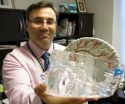(Press-News.org) One of nature's mysteries is how plants survive impact by the huge amounts of energy contained in the sun's rays, while using this energy for photosynthesis. The hypothesis is that the light-absorbing proteins in the plant's blades quickly dissipate the energy throughout the entire protein molecule through so-called protein quakes. Researchers at DTU Physics have now managed to successfully 'film' this process.
Both plants, algae and bacteria contain light-absorbing proteins which play a role in photosynthesis and thus how the organisms produce energy. However, it has long been a mystery how the organisms survive the sun's powerful rays while at the same time harvesting solar energy.
The hypothesis is that the light-absorbing proteins in the plants' blades quickly dissipate the energy throughout the entire protein molecule through quakes. Researchers at DTU Physics have now managed to successfully confirm the hypothesis.
Together with researchers from Stanford University, Tim Brandt van Driel and Kasper Skov Kjær from DTU Physics have investigated the dynamics of a protein from a bacterial photosynthesis when exposed to sunlight[SFK1] . Using a free electron laser that sends impulses lasting less than a femtosecond (0.000000000000001 sec. /10-15 sec.), the researchers have successfully filmed the so-called protein quakes which so far have just been a theoretical explanation of how the proteins survive the solar energy bombardment.
During a protein quake, the protein structure, evenly and harmlessly distributes the solar energy across the entire protein.
In addition to confirming the hypothesis about the proteins' survival strategy, the experiment is also part of the method development for examining light absorption by photosynthesis proteins and electron transfers, which are again relevant for utilising solar energy in, for example, solar cells and other light-absorption systems.
The ground-breaking results were published in the journal Nature Methods on 10 August 2014.
INFORMATION:
DTU researchers film protein quake for the first time
2014-08-27
ELSE PRESS RELEASES FROM THIS DATE:
A prescription for better stroke care
2014-08-27
TORONTO, Aug. 27, 2014 – Stroke patients are 70 per cent more likely to continue taking their stroke prevention medications one year later if they have a prescription in hand when discharged – according to researchers at St. Michael's Hospital and the Institute for Clinical Evaluative Sciences (ICES).
Using data from 11 stroke centres, researchers determined how many Ontarians were taking their medications one week, one year and two years after having a stroke. The results reveal the importance of simple interventions, such as giving a prescription to a patient before ...
The roots of human altruism
2014-08-27
VIDEO:
Sakis play the group service game.
Click here for more information.
Scientists have long been searching for the factor that determines why humans often behave so selflessly. It was known that humans share this tendency with species of small Latin American primates of the family Callitrichidae (tamarins and marmosets), leading some to suggest that cooperative care for the young, which is ubiquitous in this family, was responsible for spontaneous helping behavior. But it ...
Fighting prostate cancer with a tomato-rich diet
2014-08-27
Men who eat over 10 portions a week of tomatoes have an 18 per cent lower risk of developing prostate cancer, new research suggests.
With 35,000 new cases every year in the UK, and around 10,000 deaths, prostate cancer is the second most common cancer in men worldwide.
Rates are higher in developed countries, which some experts believe is linked to a Westernised diet and lifestyle.
To assess if following dietary and lifestyle recommendations reduces risk of prostate cancer, researchers at the Universities of Bristol, Cambridge and Oxford looked at the diets and lifestyle ...
Leading scientists call for a stop to non-essential use of fluorochemicals
2014-08-27
Fluorochemicals are synthetically produced chemicals, which repel water and oil and are persistent towards aggressive physical and chemical conditions in industrial processing. These characteristics have made the fluorochemicals useful in numerous processes and products, such as coatings for food paper and board.
The problem with fluorochemicals is that they are difficult to break down and accumulate in both humans and the environment. Some fluorochemicals have known correlations with harmful health effects, such as cancer, increased cholesterol and a weaker immune system ...
Penn paleontologists describe a possible dinosaur nest and young 'babysitter'
2014-08-27
Dinosaurs are often depicted as giant, frightening beasts. But every creature is a baby once.
A new examination of a rock slab containing fossils of 24 very young dinosaurs and one older individual is suggestive of a group of hatchlings overseen by a caretaker, according to a new study by University of Pennsylvania researchers.
Penn's Brandon P. Hedrick and Peter Dodson led the work, collaborating with researchers from China's Dalian Museum of Natural History, where the specimen is held. Hedrick is a doctoral student in the School of Arts & Sciences' Department of Earth ...
Potential therapy for incurable Charcot-Marie-Tooth disease
2014-08-27
This news release is available in German.
Charcot-Marie-Tooth disease type 1A is the most common inherited disease affecting the peripheral nervous system. Researchers from the Department of Neurogenetics at the Max Planck Institute of Experimental Medicine and University Medical Centre Göttingen have discovered that the maturity of Schwann cells is impaired in rats with the disease. These cells enwrap the nerve fibres with an insulating layer known as myelin, which facilitates the rapid transfer of electrical impulses. If Schwann cells cannot mature correctly, ...
Potential therapy for the Sudan strain of Ebola could help contain some future outbreaks
2014-08-27
Ebola is a rare, but deadly disease that exists as five strains, none of which have approved therapies. One of the most lethal strains is the Sudan ebolavirus (SUDV). Although not the strain currently devastating West Africa, SUDV has caused widespread illness, even as recently as 2012. In a new study appearing in the journal ACS Chemical Biology, researchers now report a possible therapy that could someday help treat patients infected with SUDV.
John Dye, Sachdev Sidhu, Jonathan Lai and colleagues explain that about 50-90 percent of ebola patients die after experiencing ...
How to prevent organic food fraud
2014-08-27
A growing number of consumers are willing to pay a premium for fruits, vegetables and other foods labelled "organic", but whether they're getting what the label claims is another matter. Now scientists studying conventional and organic tomatoes are devising a new way to make sure farms are labelling their produce appropriately. Their report, which appears in ACS' Journal of Agricultural and Food Chemistry, could help prevent organic food fraud.
Researchers from the Bavarian Health and Food Safety Authority and the Wuerzburg University note that the demand for organic ...
New study throws into question long-held belief about depression
2014-08-27
New evidence puts into doubt the long-standing belief that a deficiency in serotonin — a chemical messenger in the brain — plays a central role in depression. In the journal ACS Chemical Neuroscience, scientists report that mice lacking the ability to make serotonin in their brains (and thus should have been "depressed" by conventional wisdom) did not show depression-like symptoms.
Donald Kuhn and colleagues at the John D. Dingell VA Medical Center and Wayne State University School of Medicine note that depression poses a major public health problem. More than 350 million ...
Fear, safety and the role of sleep in human PTSD
2014-08-27
The effectiveness of post-traumatic stress disorder (PTSD) treatment may hinge significantly upon sleep quality, report researchers at the University of California, San Diego School of Medicine and Veterans Affairs San Diego Healthcare System in a paper published today in the Journal of Neuroscience.
"I think these findings help us understand why sleep disturbances and nightmares are such important symptoms in PTSD," said Sean P.A. Drummond, PhD, professor of psychiatry and director of the Behavioral Sleep Medicine Program at the VA San Diego Healthcare System. "Our study ...



